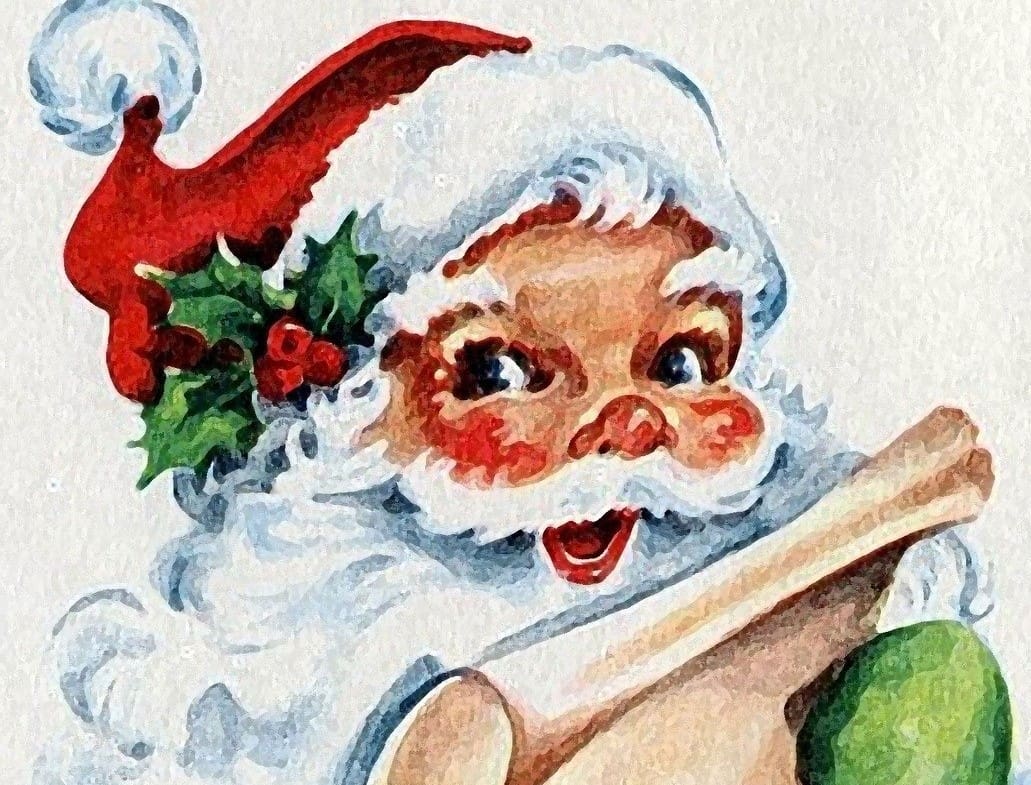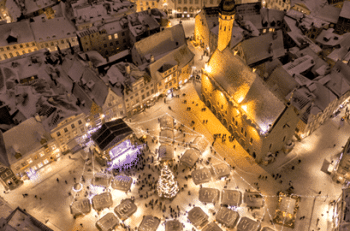Santa Claus is an iconic figure in popular culture that has been celebrated for generations. He is best known for delivering gifts to children on Christmas Eve, often coming down chimneys and leaving presents in stockings hung by the fireplace.
Santa is associated with joy, generosity and kindness; he symbolises the spirit of giving during the festive season.
But he has also become a part of global culture, with his image appearing in artwork, films, television programmes and books.
His legend also transcends religion and is embraced by people of all beliefs – he really is an all-inclusive figurehead in a multicultural world.
Why is Santa so popular?
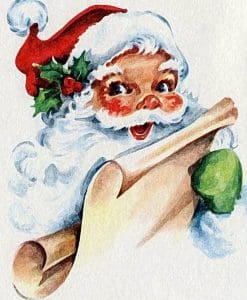 Santa’s popularity may be due to his association with tradition and the feelings of nostalgia that surround him; many celebrate him as a symbol of childhood innocence and joy.
Santa’s popularity may be due to his association with tradition and the feelings of nostalgia that surround him; many celebrate him as a symbol of childhood innocence and joy.
Santa is also seen as a symbol of hope, which makes him more important during times of difficulty or distress.
He often appears in Christmas stories as an example of how to remain positive and generous despite adversity.
Santa Claus reminds us that it is possible to make miracles happen if we come together and put our faith in the spirit of goodwill and kindness.
oooOooo
Santa’s official YouTube channel
Did you know that Santa has an official YouTube channel? Well, he does and there’s a range of great content for young and old to enjoy.
In his bio, Santa admits he is a big fan of mince pies (who isn’t?), and he loves to sing Christmas songs.
The bio also makes clear that he is also known as Kris Kringle, Father Christmas and Saint Nicholas. And, Santa, obvs.
Below, Santa sings ‘ Ho ho ho, I love mince pies!’ – a cracking tune enjoyed by nearly 200,000 viewers so far.
oooOooo
The history of Santa Claus
Santa Claus is believed to have started on his road to celebrity as Saint Nicholas.
Legends about the saint can be traced back to the 4th century in Greece when he is said to have been born around 280 AD in Patara, Lycia (which is modern-day Turkey).
In his early life, he was a devout Christian and performed many miracles, including saving three poor sisters from poverty by providing them with dowries so they could be married.
In the Middle Ages, St Nicholas became a popular figure in Europe and was renowned for his generosity towards children and the needy.
In Holland he is known as Sinterklaas.
And over time, his original image as a religious figure faded and was replaced by the modern image of Santa Claus.
This transformation began in the 1820s when various writers began to incorporate elements of Dutch folklore into their stories about St Nicholas, and his legend grew further with the publication of “A Visit from Saint Nicolas” (1823) by Clement Clarke Moore.
The image of Santa Claus as a jolly, red-suited man delivering gifts around the world on Christmas Eve with the help of flying reindeer was popularised in the late 19th century by the illustrations of Thomas Nast.
His cartoons helped spread belief in Santa Claus all over North America and Europe.
Today, Santa Claus is a beloved figure in many cultures and is celebrated during the Christmas season – and he remains a symbol of joy, goodwill, and generosity towards those in need.
Santa’s relevance today
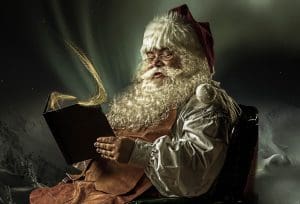 In today’s modern world, Santa Claus has become a symbol of Christmas cheer and family fun, bringing joy to children and adults alike.
In today’s modern world, Santa Claus has become a symbol of Christmas cheer and family fun, bringing joy to children and adults alike.
He is often featured in popular culture and can even be seen helping businesses promote their products around the festive season.
While he may no longer have any direct connection with the Christian faith, he is still a beloved relic of Christmas culture.
Santa has also become more commercialised over time – in particular, his iconic red suit and white beard are seen as key identifiers for the festivities.
Although this perception may have sprung from secularisation of St Nicholas’ original legacy, many people still view Santa Claus as a symbol of generosity and good will.
Santa and his iconic red and white suit
Santa Claus is instantly recognisable for his distinctive red and white suit, which symbolises the joy of the Christmas season.
Santa’s reindeer are iconic symbols of travel that have been part of his legend since the early 1800s. You can read more about Santa’s reindeer, including Rudolph, in this Christmas.co.uk article.
Also, Santa is often depicted with a sleigh which is said to be pulled by these reindeer on Christmas eve.
And the reason why children leave milk and treats out for him stems from the generosity shown by St Nicholas in the 4th century.
Now, Santa has become known for his jolly personality, white beard and round belly attributed to his love of treats left by children on Christmas Eve.
oooOooo
Santa’s Origin Story
This animated history of Santa Claus explains really well the background of Santa, where he comes from, and why he is revered today.
This US production from Uncivil History is very good and tells the story extremely well. Though we may have questions about the allegation that Santa supported the Union during the US civil war.
Aimed at young children, the video is ‘kid friendly’ and the producers also urge ‘no spoilers, please!’.
oooOooo
How old is Santa Claus?
 The age of Santa Claus is a subject that has been debated for years, with many believing him to be ageless.
The age of Santa Claus is a subject that has been debated for years, with many believing him to be ageless.
Some stories claim that he was born in the 4th century, making him more than 1,500 years old.
However, others point out that his magical powers may enable him to remain eternally young.
Whatever the case may be, Santa Claus is an important part of Christmas traditions that will remain for many years to come.
Where is Santa?
Where is Santa Claus? This is a question that is often asked by children and adults alike during the festive season. The answer, of course, is everywhere!
Santa can be found in the hearts of people all over the world who believe in his message of peace, joy and giving.
However, the most popular place to encounter Santa is in shops and shopping centres where children can sit on his lap and ask for their Christmas wishes.
Does Santa live at the North Pole?
Yes, the popular image of Santa Claus living at the North Pole is a widely accepted belief.
According to legend, Santa and his elves have been living in this remote location for centuries, preparing for the Christmas season.
It’s said that he has a workshop full of toys and presents, as well as several reindeer ready to take him on his annual journey.
Is Santa Claus real?
Many people believe that Santa is real because of the kindness and joy he brings to families during Christmas.
Others believe that Santa is a magical figure who visits us every year and brings presents to those who have been good throughout the year.
Regardless of what you choose to believe, it’s important to remember that Santa Claus is a symbol of kindness and goodwill.
He reminds us to be generous and kind throughout the festive season, inspiring us to spread joy and cheer wherever we go.
oooOooo
NORAD tracks Santa Claus
This is a great video from NORAD about their tracking of Santa. 2023 will be the 68th year they have done so!
There’s a Hollywood trailer feel to the production which is aimed for viewers of all ages – and underpins the notion that Santa knows when children have been good or bad!
See below for more explanation about how this Santa tracker works – and when it is available for children. It’s a great way to build excitement on Christmas Eve – and it shows just how hard Santa and his reindeer work through the night delivering so many presents.
The Christmas.co.uk team loved it!
oooOooo
What is the Santa tracker?
The Santa Tracker is an online tool that allows users to follow the mythical journey of Santa Claus on Christmas Eve.
It is believed that every year, Santa travels around the world in a single night delivering presents to children.
The Santa Tracker helps people keep track of his progress and follow his route as he visits millions of homes and brings joy to families everywhere.
The tracker is powered by advanced technology and provides real-time updates on Santa’s location.
Who runs the Santa tracker?
The Santa Tracker is run by the North American Aerospace Defense Command (NORAD). NORAD is a US-Canadian organisation responsible for monitoring aerospace activity in North America.
They use their high-tech radar and satellite systems to detect and track Santa as he travels around the world delivering presents on Christmas Eve.
This is an innovative tool that brings joy and excitement to homes across the world.
It also serves as a great reminder of the kindness and joy that Santa Claus brings to families each year.
So, make sure to follow NORAD’s Santa Tracker this Christmas – you’re sure to have a lot of fun!
What is the science behind Santa’s incredible journey on Christmas Eve?
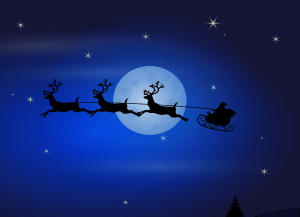 Every year, millions of people around the world eagerly track Santa’s progress on his amazing annual journey.
Every year, millions of people around the world eagerly track Santa’s progress on his amazing annual journey.
While we often think of this as a magical event, there is a lot of science behind Santa’s incredible journey.
The most important factor in Santa’s success is speed.
According to the NORAD Santa Tracker, Santa must travel at least 650 miles per second to reach children all over the world in just one night!
This means that his sleigh is travelling much faster than the speed of sound.
Santa’s success also depends on a careful balance between gravity and air resistance.
The sleigh must move fast enough to reach its destination in time, but slow enough that Santa can safely deliver presents without crashing into homes or mountains!
Finally, Santa relies on physics principles such as buoyancy and lift to help him travel around the world.
Santa and his reindeer are quite light, so they can move up and down with the air currents to navigate around obstacles such as mountains.
Ultimately, Santa’s impressive journey relies on a perfect balance between science and magic!
With the help of advanced technology, NORAD can track Santa every step of the way and help make sure he reaches children all over the world.
oooOooo
The Science of Santa: How Father Christmas Delivers Presents
For many people, the science of how Santa manages to deliver so many presents can be confusing, but this Sky News item explains it really well (at least for the Christmas.co.uk team, anyway!).
Did you know that Santa must travel at 156,579km/h (which is glacial compared to the speed of light at 1080000000km/h) to deliver all his presents? And that he makes 366m visits to children’s homes? And that his journey on Christmas Eve is 7.5 million kilometres?
No wonder he needs a few biscuits and drinks to help him through the night!
He also probably needs a rest since he will have travelled at an average speed of Mach 100! The fastest military jet travels at Mach 5!
oooOooo
What are some of the traditions associated with Santa?
Santa Claus has become an integral part of Christmas celebrations and there are many traditions associated with the jolly old man.
One of the most popular traditions is leaving out milk and biscuits for Santa on Christmas Eve.
This delicious snack serves as a tasty way to thank Santa for his hard work and to make sure he has enough energy for his long night ahead.
Another common tradition is leaving out carrots or hay for Santa’s reindeer.
Children place a small plate of these treats near the chimney, believing that Santa’s trusty helpers will enjoy them after their long journey around the globe.
Finally, there is the tradition of writing letters to Santa.
Every year, children write to Santa sharing their Christmas wishes and dreams.
These letters are filled with joy and optimism, and they serve as a reminder of the magic that Santa brings to Christmas.
Here are five facts that might surprise people about Santa
- Santa’s reindeer have been around since ancient times – the legends of Santa Claus and his reindeer can be traced back to Norse mythology, with the first written reference dating back to the 16th century
- There are 11 distinct names for the character we recognise as Santa around the world – and hundreds more for other creations from history and fable.
- Santa has a PhD – The University of Lapland in Finland awarded Santa Claus an honorary doctorate in 2008 for his incredible commitment to spreading joy and happiness around the world
- There is a real-life Santa Claus village – There is an official Santa Claus Village located in Rovaniemi, Finland. It is home to a post office, gift shops, restaurants, and even an ice hotel! Visitors can meet Santa himself there on most days of the year
- Santa is a member of the International Spaceman’s Guild – since 1965, Santa has allegedly been a member of the International Spaceman’s Guild to obtain permission for his yearly travels around the world
- Santa has a secret language – according to some accounts, Santa speaks a secret language called ‘Santa-ese’ when he talks to elves and reindeer
- Elves are the only helpers allowed at the North Pole – that’s according to the official Santa Claus Code of Ethics
- Santa gives presents to pets too – while Santa is known for giving presents to all good boys and girls, he also leaves presents for well-behaved pets as well!
Why we love Santa Claus
Santa Claus is an iconic and beloved figure that has become an important part of Christmas traditions around the world.
His image has been embraced by many cultures, with his generous spirit and jolly demeanour providing joy during the festive season.
Santa’s popularity lies in his timeless ability to evoke feelings of peace, hope, joy and generosity in people of all ages and backgrounds.
Which compared to the speed of light, is quite a slow pace…

